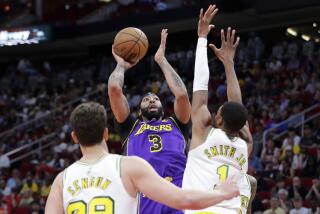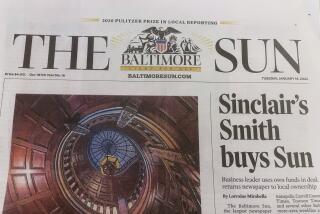Maxwell Signs Formal Agreement to Buy N.Y. News
- Share via
NEW YORK — British press baron Robert Maxwell on Thursday signed a final agreement to buy the battered but still brazen New York Daily News from Tribune Co., the Chicago-based media group that had threatened to shut the paper down today unless it were sold.
“Whether carried under the arm of straphangers, sung in the lyrics of Broadway shows or having its building and editorial floor be the set for the fabled ‘Superman,’ the News became and remains an integral part of New York’s heritage,” Charles Brumback, president of Tribune Co., said at the signing.
For the sale to be completed, the members of the paper’s nine striking unions must still ratify more than $70 million in annual concessions that their leaders agreed to earlier this week--a prospect the leaders insist will not be a problem.
“All of our efforts will come to nothing if the ratification process is not handled speedily (and) with generosity,” Maxwell said during the signing ceremony held in the auditorium of the Art Deco-style News headquarters on East 42nd Street. “Let bygones be bygones, and let us get on with producing the best Daily News that we are capable of doing.”
A bright red and white Daily News banner was stretched across the back of the stage. To one side of the podium, an easel held a blowup of Wednesday’s front page, which featured a large picture of Maxwell in a Daily News baseball cap next to the headline “Maxwell’s Plum”--a pun on the name of a well-known New York restaurant.
Maxwell has already begun working on stabilizing the paper. He reportedly met Wednesday with gossip columnist Liz Smith, who has been working without a contract for months. He also has said he wants to rehire columnist Jimmy Breslin. As for adding bare-chested women on Page 3, as he displays in his London Daily Mirror, Maxwell has said: “Certainly not.”
Maxwell has said that one of his priorities is to introduce color printing at the paper. He was at the forefront in the use of color in England, which was considered a key factor in his turning around the Mirror.
The News will continue to be published under Tribune’s management through next Wednesday and, beginning Thursday, will be published by Maxwell--if labor contracts are ratified.
Tribune Co. decided to sell the News after a two-year plan to wrest what it called “management rights” over the workplace from the unions resulted in a bitter four-month strike and stalemated labor talks.
The strike has halved the News’ circulation to, at best, 600,000 and chased away many of its advertisers. But News Publisher James Hoge said 16 advertisers, including the paper’s two largest retail accounts--the Macy’s and Alexander’s department store chains--have indicated that they intend to return.
Wall Street analysts said Maxwell must first concentrate on restoring the News’ circulation.
“He has to get newspapers on every stand he can get them on, and extra copies everywhere, just to make certain everyone who wants one can get it,” said J. Kendrick Noble of Noble Consultants. “He probably needs some kind of ad campaign--radio, perhaps TV--and make a play to bring back Breslin and as many of the top-name writers as he can.”
Maxwell will probably have to keep ad rates low as well. “Ultimately, advertising follows circulation,” said John Reidy, an analyst with Smith Barney, Harris Upham & Co. And in the current depressed New York economy, “there isn’t much advertising out there.”
All this will make life more difficult for the New York Post, owned by real estate developer Peter Kalikow, and somewhat more complicated for New York Newsday, owned by Times Mirror Co., publisher of the Los Angeles Times. Like the News, both are tabloids.
Privately, Kalikow has indicated that the Post is still not making money, analysts said, despite the fact that its circulation is up nearly 200,000 during the strike to 650,000. One problem is that the Post has no paper on Sunday, the day when papers typically make half their revenue.
With the News on strike, most of the crucial Sunday gains went to Newsday. The New York edition of Long Island-based Newsday saw its Sunday circulation swell during the strike by nearly 250,000 to more than 435,000.
More to Read
The biggest entertainment stories
Get our big stories about Hollywood, film, television, music, arts, culture and more right in your inbox as soon as they publish.
You may occasionally receive promotional content from the Los Angeles Times.










